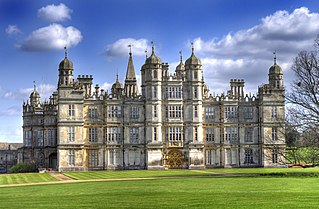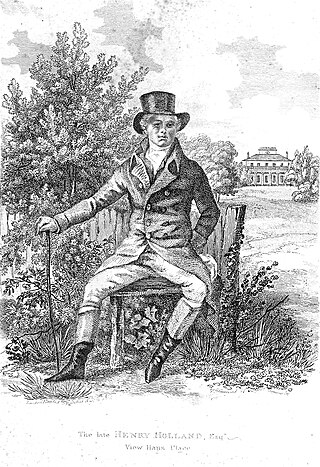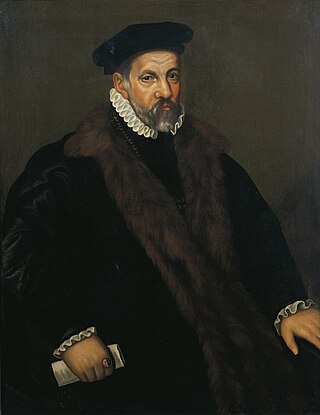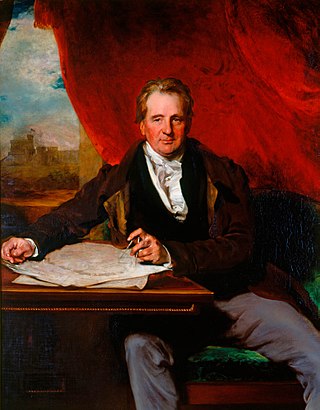
Southgate is a suburban area of north London, England, in the London Borough of Enfield, 8 miles (13 km) north of Charing Cross.

William Kent was an English architect, landscape architect, painter and furniture designer of the early 18th century. He began his career as a painter, and became Principal Painter in Ordinary or court painter, but his real talent was for design in various media.

Sir William Chambers was a Swedish-Scottish architect, based in London. Among his best-known works are Somerset House, and the pagoda at Kew. Chambers was a founder member of the Royal Academy.

Burghley House is a grand sixteenth-century English country house near Stamford, Lincolnshire. It is a leading example of the Elizabethan prodigy house, built and still lived in by the senior (Exeter) branch of the Cecil family and is Grade I listed.

Henry Holland was an architect to the English nobility.

Edmonton is a town in north London, England within the London Borough of Enfield, a local government district of Greater London. The northern part of the town is known as Lower Edmonton or Edmonton Green, and the southern part as Upper Edmonton. Situated 8.4 miles (13.5 km) north-northeast of Charing Cross, it borders Enfield to the north, Chingford to the east, and Tottenham to the south, with Palmers Green and Winchmore Hill to the west. The population of Edmonton was 82,472 as of 2011.
Elsyng Palace was a Tudor palace on the site of what are now the grounds of Forty Hall in Enfield, north London. Its exact location was lost for many years until excavations were carried out in the 1960s.

Theobalds House in the parish of Cheshunt in the English county of Hertfordshire, north of London, was a significant stately home and (later) royal palace of the 16th and early 17th centuries.

Arnos Grove is an area of north London, England, within the London Borough of Enfield. It is centred 7.5 miles (12 km) north of Charing Cross. It is adjacent to New Southgate. The natural grove, larger than today, was for many centuries the largest woodland in the chapelry of Southgate in the parish of Edmonton. It became inter-related with Arnos Park when its owner was permitted to enclose much of its area through the widespread legal practice of inclosure of the common land to create the former park, the heart of which is now public parkland.

Thomas Wilson (1524–1581), Esquire, LL.D., was an English diplomat and judge who served as a privy councillor and Secretary of State (1577–81) to Queen Elizabeth I. He is remembered especially for his Logique (1551) and The Arte of Rhetorique (1553), which have been called "the first complete works on logic and rhetoric in English".

Pymmes Brook is located in North London and named after William Pymme, a local landowner. It is a minor tributary of the River Lea. The brook mostly flows through urban areas and is particularly prone to flooding in its lower reaches. To alleviate the problem the brook has been culverted in many areas. Part of it is a Site of Borough Importance for Nature Conservation, Grade II.

Pymmes Park is located in Edmonton, London and is bordered by the North Circular Road.

Millfield House is a Grade II* listed building located in Silver Street, Edmonton, London. Previously a private house, it has been used as an arts centre since 1979.

The Pymmes Brook Trail is located in the London Boroughs of Barnet, Enfield and Haringey and is just under 13 miles (21 km) long. The brook is named after William Pymme, a local landowner.

St Katherine Coleman was a parish church in the City of London, situated in St Katherine's Row, on the south side of Fenchurch Street, in Aldgate Ward. Of medieval origin, it narrowly escaped destruction in the Great Fire of London in 1666, but was rebuilt in the eighteenth century. The church closed in November 1926 and was demolished soon afterwards.

Panshanger was a large country house located between the outer edge of Hertford and Welwyn Garden City in Hertfordshire, England.
Grove House School was a Quaker school in Tottenham, United Kingdom.

Sir Jeffry Wyatville was an English architect and garden designer. Born Jeffry Wyatt into an established dynasty of architects, in 1824 he was allowed by King George IV to change his surname to Wyatville. He is mainly remembered for making alterations and extensions to Chatsworth House and Windsor Castle.
William Pymme was a landowner in Edmonton, now in London, a member of the Pymme family who had been granted land by Edward II in the 14th century.

Minchington Hall, Mincington Hall, or Minchenden House was a country house and estate in Southgate, then in the county of Middlesex in England, and now in Greater London. It was on Southgate Green and the south side of Waterfall Road, and adjoined Arnolds slightly further east, which was originally less significant than Minchington. The estate was merged into Arnos Grove in 1853 and the house demolished.




















